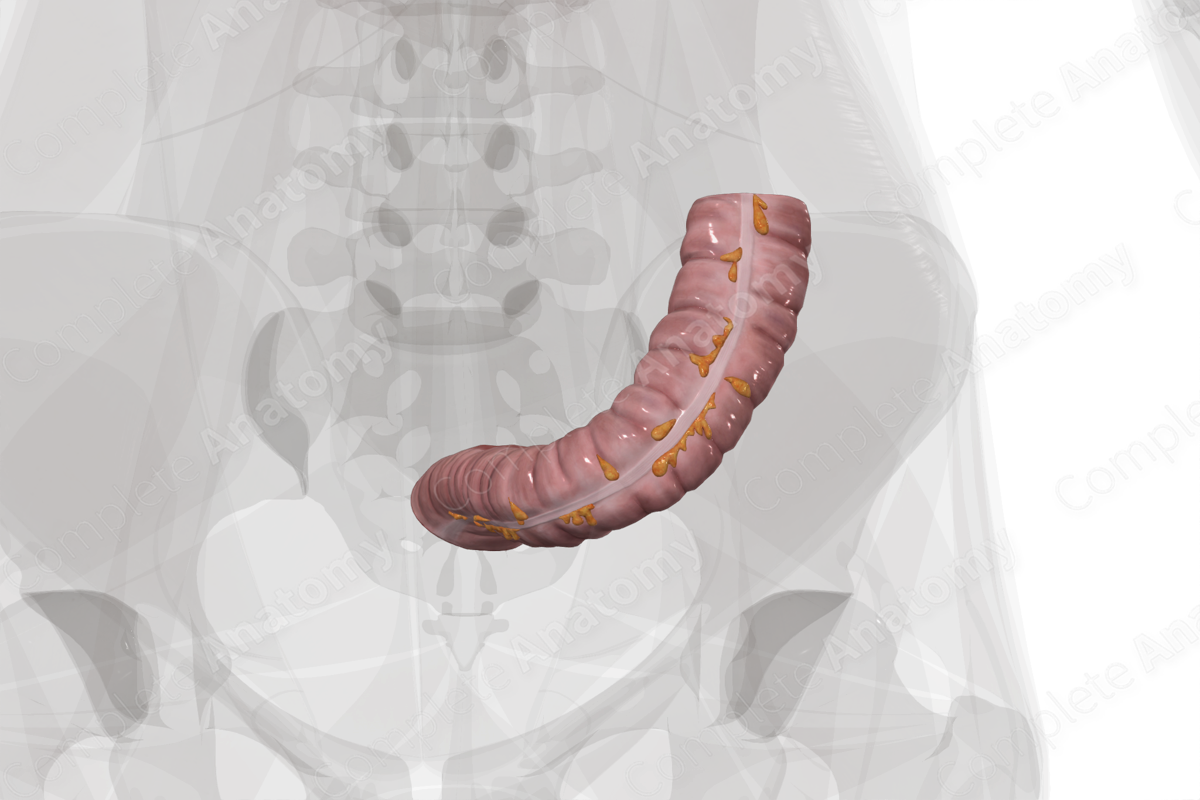
Quick Facts
Location: Extends from left iliac fossa into the true pelvis, to the level of S3 vertebra.
Arterial Supply: Sigmoid arteries.
Venous Drainage: Sigmoid veins.
Innervation: Parasympathetic: pelvic splanchnic (S2-S4); Sympathetic: inferior mesenteric plexus, inferior hypogastric plexus; Enteric innervation.
Lymphatic Drainage: Inferior mesenteric lymph nodes.
Related parts of the anatomy
Structure/Morphology
The sigmoid colon is a continuation of the descending colon in the left iliac fossa. Its name is derived from its characteristic S-shape. The sigmoid colon is intraperitoneal and is surrounded by the sigmoid mesocolon.
The cross-sectional microarchitecture of the sigmoid colon is similar to the general makeup of the gastrointestinal tract. It has a mucosa, submucosa, muscularis layer (with an inner circular layer and outer longitudinal bands, the teniae coli), and thin outer serosal covering. However, the sigmoid colon has particularly notable haustra and omental appendices. Additionally, the teniae coli are wider and merge distally to form a complete layer of longitudinal smooth muscle, a feature that indicates the transition to the rectum (Standring, 2016).
Anatomical Relations
The sigmoid colon is continuous with the descending colon in the lesser pelvis. It courses in a posteromedial direction and crosses in front of the sacrum towards the midline where it curves at the level of the third sacral vertebra (S3) to become the rectum.
Several structures sit posterior to the sigmoid colon as they travel inferiorly to the pelvis or the lower limb. These may include, from lateral to medial, the genitofemoral nerve, left gonadal vessels, obturator nerve, ureters, and the left internal iliac vessels.
Function
The sigmoid colon is the last chance for absorption of nutrients, vitamins, and water before transportation of waste material into the rectum (Koeppen and Stanton, 2009).
Arterial Supply
The inferior mesenteric artery gives rise to 2–5 sigmoidal arteries as it travels inferiorly towards the pelvis (Standring, 2016). Each sigmoid artery branches into ascending and descending branches which anastomose with the branch above and below. Thus, their distal ends form anastomotic loops with adjacent sigmoid arteries.
The ascending branch of the uppermost sigmoidal artery anastomoses with the descending branch of the left colic artery. Inferiorly, the descending branch of the final sigmoid artery anastomoses with the superior anorectal artery.
Venous Drainage
The venous drainage pattern is similar to the arterial supply. Several sigmoid veins drain into the inferior mesenteric vein.
Innervation
Parasympathetic innervation is derived from the pelvic splanchnic nerves (S2-S4) and visceral afferents (S2-S4) are also present. Sympathetic innervation of the sigmoid colon may arise from several sources: the inferior mesenteric plexus, the superior or inferior hypogastric plexuses, or the iliac plexus.
The enteric system consists of two plexuses of densely packed small neurons. Meissner’s plexus lies in the submucosal layer and Auerbach’s myenteric plexus lie between the outer longitudinal and inner circular smooth muscle layers. These systems of nerves control mucosal and peristaltic function (Standring, 2016).
Lymphatic Drainage
The lymph of the sigmoid colon is drained by the inferior mesenteric lymph nodes via the sigmoid and superior rectal lymph nodes (Földi et al., 2012).
List of Clinical Correlates
- Volvulus of the sigmoid colon
- Diarrhea
References
Földi, M., Földi, E., Strößenreuther, R. and Kubik, S. (2012) Földi's Textbook of Lymphology: for Physicians and Lymphedema Therapists. Elsevier Health Sciences.
Koeppen, B. M. and Stanton, B. A. (2009) Berne & Levy Physiology, Updated Edition E-Book. Elsevier Health Sciences.
Standring, S. (2016) Gray's Anatomy: The Anatomical Basis of Clinical Practice. Gray's Anatomy Series 41st edn.: Elsevier Limited.




